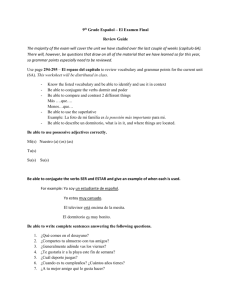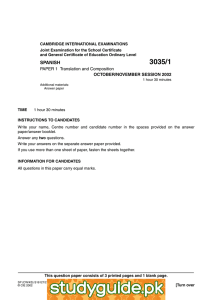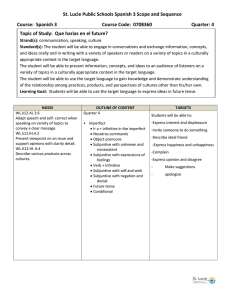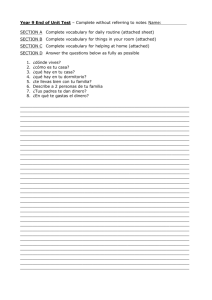St. Lucie Public Schools Spanish 4 Scope and Sequence Quarter: 2
advertisement
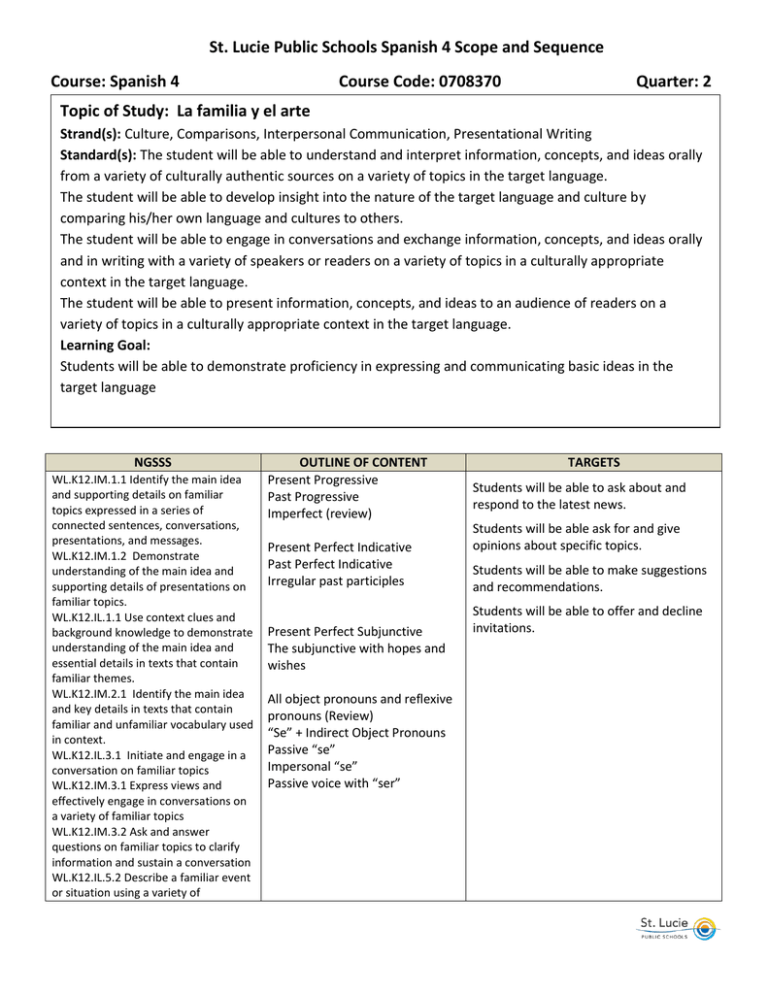
St. Lucie Public Schools Spanish 4 Scope and Sequence Course: Spanish 4 Course Code: 0708370 Quarter: 2 Topic of Study: La familia y el arte Strand(s): Culture, Comparisons, Interpersonal Communication, Presentational Writing Standard(s): The student will be able to understand and interpret information, concepts, and ideas orally from a variety of culturally authentic sources on a variety of topics in the target language. The student will be able to develop insight into the nature of the target language and culture by comparing his/her own language and cultures to others. The student will be able to engage in conversations and exchange information, concepts, and ideas orally and in writing with a variety of speakers or readers on a variety of topics in a culturally appropriate context in the target language. The student will be able to present information, concepts, and ideas to an audience of readers on a variety of topics in a culturally appropriate context in the target language. Learning Goal: Students will be able to demonstrate proficiency in expressing and communicating basic ideas in the target language NGSSS WL.K12.IM.1.1 Identify the main idea and supporting details on familiar topics expressed in a series of connected sentences, conversations, presentations, and messages. WL.K12.IM.1.2 Demonstrate understanding of the main idea and supporting details of presentations on familiar topics. WL.K12.IL.1.1 Use context clues and background knowledge to demonstrate understanding of the main idea and essential details in texts that contain familiar themes. WL.K12.IM.2.1 Identify the main idea and key details in texts that contain familiar and unfamiliar vocabulary used in context. WL.K12.IL.3.1 Initiate and engage in a conversation on familiar topics WL.K12.IM.3.1 Express views and effectively engage in conversations on a variety of familiar topics WL.K12.IM.3.2 Ask and answer questions on familiar topics to clarify information and sustain a conversation WL.K12.IL.5.2 Describe a familiar event or situation using a variety of OUTLINE OF CONTENT Present Progressive Past Progressive Imperfect (review) Present Perfect Indicative Past Perfect Indicative Irregular past participles Present Perfect Subjunctive The subjunctive with hopes and wishes All object pronouns and reflexive pronouns (Review) “Se” + Indirect Object Pronouns Passive “se” Impersonal “se” Passive voice with “ser” TARGETS Students will be able to ask about and respond to the latest news. Students will be able ask for and give opinions about specific topics. Students will be able to make suggestions and recommendations. Students will be able to offer and decline invitations. St. Lucie County Public Schools Spanish 4 Scope and Sequence sentences and with supporting details WL.K12.IM.3.3 Express degrees of emotion and respond appropriately to the feelings and emotions of others. Common Vocabulary Asking about the latest news el (anillo de) compromiso casarse (con) comprometerse la cuñada el cuñado dar a luz divorciado(a)(s) divorciarse (de) el divorcio estar casado(a)(s) Fíjate que se ha casado. el funeral graduarse (de) la hermanastra el hermanastro la madrastra la medio hermana el medio hermano nacer el padrastro Pues, sigue trabajando... ¿Qué anda haciendo...? ¿Qué me cuentas de...? ¿Qué sabes de...? la reunión familiar Según tengo entendido, ... separado(a) separarse (de) la suegra el suegro engagement (ring) to marry to get engaged sister-in-law brother-in-law to give birth divorced to divorce divorce to be married Get this: he/she got married. funeral to graduate (from) stepsister stepbrother stepmother half sister half brother to be born stepfather Well, he‘s/she‘s still working . . . What‘s . . . up to? What can you tell me about . . . ? What do you know about . . . ? family reunion From what I understand, . . . separated to separate mother-in-law father-in-law Reacting to news Me has dejado boquiabierto(a). ¡No me digas! You‘ve left me speechless. You don‘t say! St. Lucie County Public Schools Spanish 4 Scope and Sequence ¡No me lo puedo creer! Qué pena que se hayan… ¡Qué sorpresa que se hayan...! I can‘t believe it! What a shame that they have . . . What a surprise that they have . . . ! Commenting on food el aguacate Al (A la)...le falta sabor, pero no sé qué le falta. el apio el bizcocho de chocolate el calabacín el camarón, los camarones la cereza los chícharos el coliflor la crema (agria) el dulce de coco Está para chuparse los dedos. Está pasada la leche. los frijoles la langosta la lima el limón las pasas el pavo (con relleno) el pepino el pollo frito el puerco asado ¡Qué asco! Sabe delicioso(a). Se me hace la boca agua. la salchicha la sandía la toronja el yogur avocado The . . . lacks flavor, but I don‘t know what‘s missing. celery chocolate cake zucchini shrimp cherry peas cauliflower (sour) cream coconut candy It‘s good enough to lick your fingers. The milk has gone bad. beans lobster lime lemon raisins turkey (with stuffing) cucumber fried chicken roast pork That‘s disgusting! It tastes delicious. It makes my mouth water. sausage watermelon grapefruit yogurt Explaining and giving excuses El/La... no sabe a nada. El/La... está salado(a)/picante. El/La... está seco(a)/no está muy dulce. Es que se me acabó... Es que se me olvidó ponerle... Se me fue la mano con... The . . . doesn‘t taste like anything. The . . . is salty/spicy. The. . . is dry/isn‘t very sweet. It‘s just that I ran out of . . . It‘s just that I forgot to add . . . I got carried away with . . . St. Lucie County Public Schools Spanish 4 Scope and Sequence Asking for and giving opinions A decir verdad, me parece... la acuarela antiguo(a) la arquitectura las artes plásticas la cinematografía clásico(a) contemporáneo(a) To tell the truth, it strikes me as . . . watercolor antique architecture plastic arts (sculpture, painting, architecture) cinematography classic contemporary ¿Cuál de estas pinturas te gusta más, la de... o la de...? Which of these paintings do you like better the one of(by) . . . or the one of (by) . . . ? el dibujo drawing esculpir to sculpt la escultura sculpture la estatua statue Este retrato fue pintado por... This portrait was painted by . . . la exposición exhibit la fotografía photography la galería gallery imaginativo(a) imaginative impresionante impressive llamar la atención to attract one’s attention Lo/La encuentro muy... I find it to be very . . . maravilloso(a) marvelous moderno(a) modern original original el puente bridge ¿Qué opinas de...? What do you think of . . .? ¿Qué te parece? What do you think of it? En realidad, admiro... Actually, I admire . . . Realista realistic tallar en madera to carve wood la torre tower Introducing and changing a topic of conversation Making suggestions and recommendations las artes dramáticas artístico(a) el ballet dramatic arts artistic ballet St. Lucie County Public Schools Spanish 4 Scope and Sequence la comedia comedy or play crear to create creativo(a) creative de buen/mal gusto in good/bad taste desempeñar (el papel de...) to play (the role of . . .) el drama drama entretenido(a) entertaining Es mejor que veas la ópera. Es formidable. It’s better for you to see the opera. It’s great. el escenario stage/scenery estridente shrill formidable great, tremendous la función performance hermoso(a) beautiful incomprensible incomprehensible la letra lyrics la melodía melody melodioso(a) melodic No te olvides de ir al ensayo de la banda. Don’t forget to go to band practice. la obra (de teatro) play la orquesta orchestra pésimo(a) terrible presentar to present el publico audience la reseña (critical) review el ritmo rhythm Sería buena idea ir al concierto de la sinfónica. It would be a good idea to go to the symphony. superficial superficial Te aconsejo que vayas a la presentación de baile folclórico. Es muy... I recommend that you go to the folk dance performance. It’s very . . . la tragedia tragedy Inviting someone to do something and turning down an invitation . . . . . . . .


